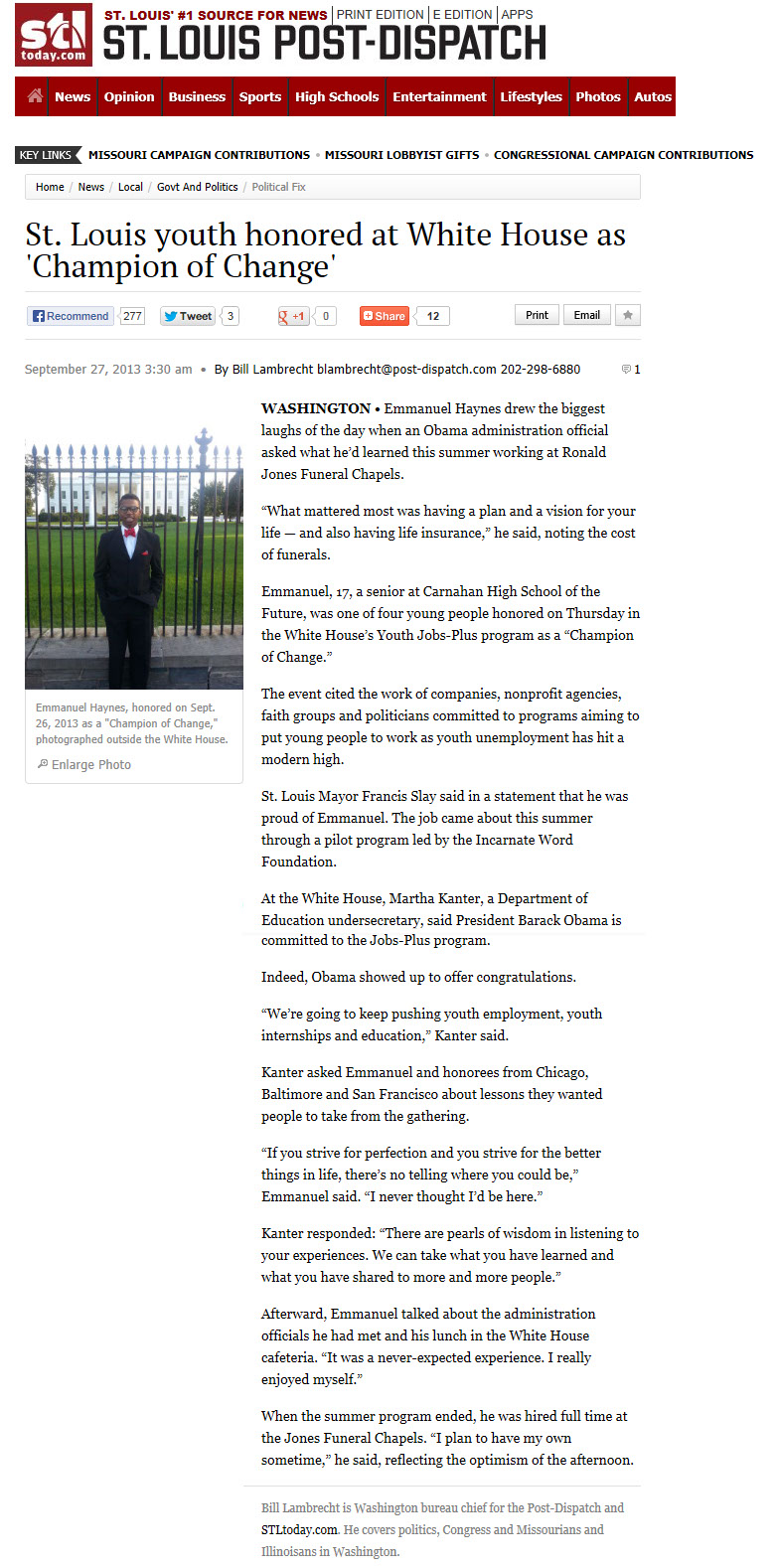NEWS

St. Louis Funeral Director has carved a life from Respecting the Dead
ST. LOUIS • The woman had been shot 11 times outside a White Castle restaurant last August, her bullet-riddled body unrecognizable to anyone who knew her.
This couldn’t be the way Angie Young’s family would see her for the last time, Ronald Jones thought.
So Jones, the owner of Ronald L. Jones Funeral Chapels on East Fair Avenue near O’Fallon Park, would spend many hours over three days reconstructing the woman, who was known by all of Jones’ workers. Afterward, an apprentice remarked that the 36-year-old single mother had never looked better.
It’s the kind of compliment for which Jones has based his business. In St. Louis, he is the go-to guy for families with a relative left disfigured by a gruesome death.
To Jones, it’s about more than the cosmetic outcome.
“It’s hard enough to lose a loved one, but to lose them twice by not being able to see them?” he said. “When I’m able to give them the opportunity to see their loved one again, it allows them to accept things and try to get some closure.”
• • •
After a person dies — in the case of an open casket service — their family normally signs their loved ones over to a funeral home, where the body is embalmed, cleaned and clothed. Makeup is applied to correct skin discolorations caused by livor mortis, when the blood shifts to the areas of the body closest to the ground.
Often, Jones takes a few more steps to get his job done.
As a “restorative artist,” the technical term for what he does, Jones has used wire, wooden stakes and even rebar to enhance a body’s appearance. He has worked on bodies that have come in seriously decomposed, missing parts and, in one case, ripped in half.
In more than 35 years, Jones says he has never turned a family away.
“I get a joy and satisfaction out of a job well done,” he said. “Of course, it’s not typical. We all have a calling. This is not something you choose.”
Jones, 65, said he was inspired as a child by undertakers because they were always dressed nicely and had flashy cars and jewelry. He went to mortuary school to earn his own. He got his first job in a funeral home when he was 19. In 1976, when he was 29, he opened Ronald L. Jones Mortuary on Riverview Boulevard near Calvary Cemetery. His mission has been to give people anything they can think to ask.
Jones is known as flamboyant, always in large round glasses — think Elton John — with large rings on both hands, wearing tailor-made suits. A black Rolls-Royce Phantom sits parked in a handicapped spot on the side of his funeral home, where he also lives.
The moniker extends to his work. Twice he has prepared men for burial standing up, which requires distinctive embalming and tilting a casket to set it at eye level with most mourners. The first time, he said, was because the dead man did not want people looking down on him. Then there was the celebrity jam session, complete with light show, at the 2005 funeral for blues musician Johnnie Johnson, who is often considered the inspiration for the Chuck Berry song “Johnny B. Goode.”
Jones was half of the focus of a 2005 documentary called “Pushing Up Daisies,” for which a film crew spent time behind the scenes with Jones and a funeral director in Michigan. In the short film’s description, it says Jones “represents the pageantry of funerals in the U.S.” He thinks of funerals more as “productions,” an ultimate send-off with big choirs and high-end accessories. Bodies have been flown in from as far away as California to get the Ronald Jones treatment.
His own send-off, “SuperJam 2099,” is already in the works. He said the spectacular will be a multiday event, complete with live performances, wardrobe changes (for him) and an $86,000 sarcophagus he started paying for years ago.
The requests from Jones’ clients include restoring loved ones whose deaths were anything but natural. He thumbed through a photo album in an empty viewing room recently, showing images of bodies he had transformed. One was of a man crushed after falling into an elevator shaft. Many were victims of gunshot wounds to the head. Jones said he can sometimes spend days on one victim to prepare for a viewing.
Chrystal Randle, an apprentice who has been working with Jones since August, said Jones is a perfectionist, often handling cases where some funeral directors would simply tell families to have a closed-casket service.
“Some won’t try to do the restoration Mr. Jones will do,” she said. “He doesn’t stop.”
Jones said his ego is partly to blame. Tell him he can’t do something, and it makes him want to do it even more.
• • •
That was the case with Garrett Pearson, 62, who died after being hit by two vehicles on Interstate 44 on April 1. Tiffany Jones, Pearson’s daughter (no relation to Ronald Jones), said she went to the St. Louis medical examiner’s Office to see her father’s body when he finally was identified two days after the accident but was turned away by officials.
“I got upset because I wanted to see my daddy and they wouldn’t let me. They kept saying, ‘You don’t want to see your dad like this.’”
She requested Ronald Jones based on previous work she had seen.
Jones said he rebuilt part of Pearson’s torso, which had been crushed in the accident, and also filled in a hole in the man’s neck where his trachea had been taken out, the effects of throat cancer.
“I didn’t even notice he was in an accident,” Tiffany Jones recalled thinking when she first saw her father at Jones’ funeral home. “I really wanted to see him one more time. To see him look like himself? That helped a whole lot.
“It was remarkable.”
Few funeral homes in the area are known specifically for work done on those whose deaths were not natural. Gerald Johnson, owner of Serenity Memorial Chapel in East St. Louis, said Ronald Jones is able to produce incredible results because of his passion for the work.
“It’s almost like he puts himself under mandate not to close a casket,” said Johnson, who has studied under Jones to learn some of his techniques. “Sometimes, a lot of embalmers will take the easy way out. That’s not the case with Ronald.”
Larry Byndon, who worked for Jones for several years in the early 2000s, said he marveled at the dedication Jones showed to his work. One case involved a man whose head had been torn apart in an accident. Over several days, he said Jones reconstructed the entire skull.
“He pieced it back together like a puzzle,” said Byndon, who now owns Bi-State Cremation and Funeral Service in Florissant. “There was nothing left. When I think of restoration, I think of Ronald Jones.
“There’s some good people out there, but he’s one of the best.”
• • •
In the back of the photo album filled with pictures of past clients are thank-you cards and short notes from family members. Many comment on Jones’ workmanship and the time he spent with them while their loved ones were in his care.
It’s all part of the job, he said.
“Some people can sing real well, and some can preach,” Jones said. “I consider myself a caregiver because (the funeral business) it’s almost like a ministry. You are coming in contact with people at their lowest point.”
